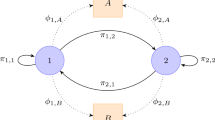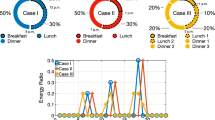Abstract
This paper describes a clustering methodology for temporal data using hidden Markov model(HMM) representation. The proposed method improves upon existing HMM based clustering methods in two ways: (i) it enables HMMs to dynamically change its model structure to obtain a better fit model for data during clustering process, and (ii) it provides objective criterion function to automatically select the clustering partition. The algorithm is presented in terms of four nested levels of searches: (i) the search for the number of clusters in a partition, (ii) the search for the structure for a fixed sized partition, (iii) the search for the HMM structure for each cluster, and (iv) the search for the parameter values for each HMM. Preliminary experiments with artificially generated data demonstrate the effectiveness of the proposed methodology.
Access this chapter
Tax calculation will be finalised at checkout
Purchases are for personal use only
Preview
Unable to display preview. Download preview PDF.
Similar content being viewed by others
References
Baum, L. E., Petrie, T., Soules, G., Weiss, N.: A maximization technique occurring in the statistical analysis of probabilistic functions of markov chains. The Annuals of Mathematical Statistics 4(1) (1970) 164–171.
Forney, G.: The viterbi algorithm. Proceedings of the IEEE 61(3) (1973) 268–277.
Dempster, A. P., Laird, N. M., Rubin, D. B.: Maximum likelihood from incomplete data via the em algorithm. Journal of Royal Statistical Society Series B(methodological) 39 (1977) 1–38.
Bahl, L. R., Brown, P. F., De Souza, P. V., Mercer, R. L.: Maximum mutual information estimation of hidden markov model parameters. Proceedings of the IEEE-IECEJ-AS International Conference on Acoustics, Speech, and Signal Processing 1 (1978) 49–52.
Juang, B. H., Rabiner, L. R.: A probabilistic distance measure for hidden markov models. AT&T Technical Journal 64(2) (1985) 391–408.
Fisher, D.: Knowledge acquisition via incremental conceptual clustering. Machine Learning 2 (1987) 139–172.
Rabiner, L. R.: A tutorial on hidden markov models and selected applications in speech recognition. Proceedings of the IEEE 77(2) (1989) 257–285.
Rabiner, L. R., Lee, C. H., Juang, B. H., Wilpon, J. G.: Hmm clustering for connected word recognition. Proceedings of the International Conference on Acoustics, Speech, and Signal Processing (1989).
Casacuberta, F., Vidal, E., and Mas B.: Learning the structure of hmm’s through grammatical inference techniques. Proceedings of the International Conference on Acoustic, Speech, and Signal Processing (1990) 717–720.
Lee, K. F.: Context-dependent phonetic hidden markov models for speaker-independent continuous speech recognition. IEEE Transactions on Acoustics, Speech, and Signal Processing 38(4) (1990) 599–609.
Casella G., George, E. I.: Explaining the gibbs sampler. The American Statistician 46(3) (1992) 167–174.
Cooper, G. F., Herskovits, E.: A bayesian method for the induction of probabilistic network from data. Machine Learning 9 (1992) 309–347.
Omohundro, S. M.: Best-first model merging for dynamic learning and recognition. Advances in Neural Information Processing Systems 4 (1992) 958–965.
Takami, J., Sagayama, S.: A successive state splitting algorithm for Efficient allo-phone modeling. Proceedings of the International Conference on Acoustics, Speech, and Signal Processing 1 (1992) 573–576.
Stolcke, A., Omohundro, S. M.: Best-first model merging for hidden markov model induction. Technical Report TR-94-003, International Computer Science Institute, 1994.
Wallace, C. S., Dowe, D. L.: Intrinsic classificatin by mml-the snob program. Proceedings of the Seventh Australian Joint Conference on Artificial Intelligence (1994) 37–44.
Biswas, G., Weinberg, J., Li, C.: Iterate: A conceptual clustering method for knowledge discovery in databases. Artificial Intelligence in Petroleum Industry: Symbolic and Computational Applications, Braunschweig, B. and Day, R.editors, Teditions Technip, 1995.
Chib, S.: Marginal likelihood from the gibbs sampling. Journal of the American Statistical Association (1995) 1313–1321.
Kass, R. E., Raftery, A. E.: Bayes factor. Journal of the American Statistical Association (1995) 773–795.
Kosaka, T., Masunaga, S., Kuraoka, M.: Speaker-independent phone modeling based on speaker-dependent hmm’s composition and clustering. Proceedings of the ICASSP’95 (1995) 441–444.
Cheeseman, P., Stutz, J.: Bayesian Classification(autoclass): Theory and results. Advances in Knowledge Discovery and Data Mining (1996) chapter 6 153–180, Fayyad, U. M., Piatetsky-Shapiro, G., Smyth, P., Uthurusamy, R.editors AAAI-MIT press.
Dermatas, E., Kokkinakis, G.: Algorithm for clustering continuous density hmm by recognition error. IEEE Transactions on Speech and Audio Processing 4(3) (1996) 231–234.
Chickering, D. M., Heckerman, D.: Efficient approximations for the marginal like-lihood of bayesian networks with hidden variables. Machine Learning 29 (1997) 181–212.
Ghahramani, Z., Jordan, M. I.: Factorial hidden markov models. Machine Leaning 29 (1997) 245–273.
Ostendorf, M., Singer, H.: Hmm topology design using maximum likelihood successive state splitting. Computer Speech and Language 11 (1997) 17–41.
Smyth, P.: Clustering sequences with hidden markov models. Advances in Neural Information Processing (1997).
Li, C.: Unsupervised Classification on temporal data. Technical Report VU-CS-TR-98-04, Vanderbilt University, April 1998.
Li, C., Biswas, G.: Clustering sequence data using hidden markov model representation. SPIE99 Conference on Data Mining and Knowledge Discovery: Theory, Tools, and Technology (1999) 14–21.
Sebastiani, P., Ramoni, M., Cohen, P., Warwick, J., Davis, J.: Discovering dynamics using bayesian clustering. Proceedings of the 3rd International Symposium on Intelligent Data Analysis (1999).
Author information
Authors and Affiliations
Editor information
Editors and Affiliations
Rights and permissions
Copyright information
© 1999 Springer-Verlag Berlin Heidelberg
About this paper
Cite this paper
Li, C., Biswas, G. (1999). Temporal Pattern Generation Using Hidden Markov Model Based Unsupervised Classification. In: Hand, D.J., Kok, J.N., Berthold, M.R. (eds) Advances in Intelligent Data Analysis. IDA 1999. Lecture Notes in Computer Science, vol 1642. Springer, Berlin, Heidelberg. https://doi.org/10.1007/3-540-48412-4_21
Download citation
DOI: https://doi.org/10.1007/3-540-48412-4_21
Published:
Publisher Name: Springer, Berlin, Heidelberg
Print ISBN: 978-3-540-66332-4
Online ISBN: 978-3-540-48412-7
eBook Packages: Springer Book Archive




